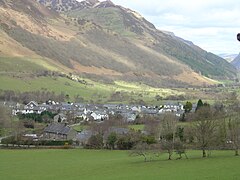Abergynolwyn (English: Mouth of the River with a Whirlpool) is a village in southern Gwynedd, Wales, located at the confluence of the Nant Gwernol and the Afon Dysynni.[1] The population of the community which is named after the village of Llanfihangel-y-Pennant was 339 at the 2011 census.
| Abergynolwyn | |
|---|---|
 Abergynolwyn | |
Location within Gwynedd | |
| OS grid reference | SH679070 |
| Community | |
| Principal area | |
| Preserved county | |
| Country | Wales |
| Sovereign state | United Kingdom |
| Post town | TYWYN |
| Postcode district | LL36 |
| Dialling code | 01654 |
| Police | North Wales |
| Fire | North Wales |
| Ambulance | Welsh |
| UK Parliament | |
| Senedd Cymru – Welsh Parliament | |
History edit
Historically, the village was part of Merionethshire and its main industry was slate quarrying. The village was founded in the 1860s to house workers at the nearby Bryn Eglwys quarry. The quarry brought in migrant workers from other areas of Wales and at one time the village had an Anglican church and three nonconformist chapels. The slate was shipped to the coast on the Talyllyn Railway. A decline in the demand for Welsh slate caused reductions in the workforce, and the quarry finally closed in 1948. Today farming, forestry and tourism are the major local industries.[2]
Talyllyn Railway edit
The village pub, the Railway Inn, is named after the Talyllyn Railway whose narrow gauge branch once reached into the heart of the village down an incline from a ledge on the hillside above. The railway now terminates at Nant Gwernol station above the village, although for many years the terminus was at Abergynolwyn Station outside the village.[3]
Local attractions edit
Llyn Mwyngil (Tal-y-llyn Lake), just upstream from Abergynolwyn is an unspoilt lake created when a massive landslide blocked the valley long ago.[4] Hiking trails to the summit of Cadair Idris start from here. The Iron Age fort on Craig yr Aderyn shows that the area was strategically important in prehistoric times. In 1221, the mediaeval Welsh castle of Castell y Bere near Llanfihangel-y-pennant was built by Llewellyn the Great, occupied by the Welsh and later besieged by forces under Edward I of England in 1282.[2]
References edit
- ^ "Landranger 124: Dolgellau and surrounding area", 1.25 inch map, Ordnance Survey
- ^ a b Taylor, Scott. "Abergynolwyn: Past and present". Archived from the original on 7 April 2016. Retrieved 26 April 2016.
- ^ "Things to Do". Talyllyn Railway. Retrieved 26 April 2016.
- ^ Stephens, Nicholas (1990). Natural Landscapes of Britain from the Air. CUP Archive. pp. 64–65. ISBN 978-0-521-32390-1.
